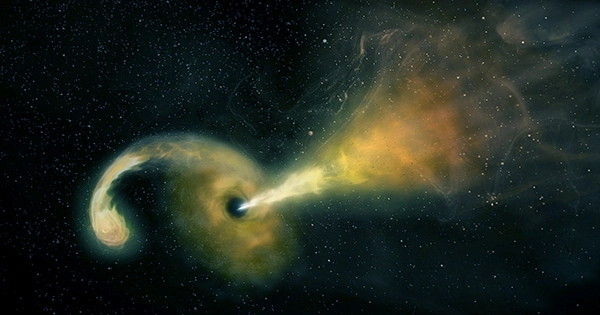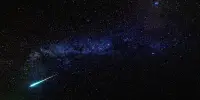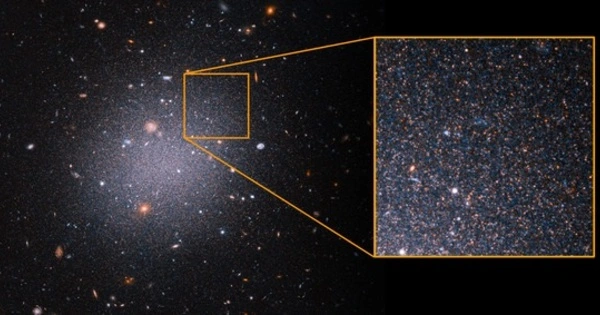Approximately once every 10,000 years, a galaxy’s supermassive black hole rips apart a passing star, igniting the galaxy’s center. When the central black hole draws in stellar material and simultaneously ejects enormous amounts of radiation, this “tidal disruption event” occurs in a flash.
Based on the burst of light that reaches observatories on Earth and in space, astronomers are aware of around 100 tidal disruption events (TDE) in distant galaxies. The majority of this light is produced by optical and X-ray radiation.
MIT astronomers have found a novel tidal disruption event that shines brilliantly in the infrared by tuning beyond the usual X-ray and UV/optical wavelengths. One of the earliest TDEs at infrared wavelengths to be directly recognized by scientists.
Furthermore, the new outburst is the closest tidal disruption event ever observed: The flare was discovered in NGC 7392, a galaxy located around 137 million light-years from Earth, corresponding to an area in our cosmic backyard one-fourth the size of the next-closest TDE.
WTP14adbjsh, the new flare, did not stand out in conventional X-ray and optical data. The scientists believe that the adjacent TDE was overlooked not because it did not generate X-rays or UV light, but because the light was masked by a massive amount of dust that absorbed the radiation and gave out heat in the form of infrared energy.
Contrary to most TDEs that have been discovered in calmer galaxies, the researchers found that WTP14adbjsh happened in a young, star-forming galaxy. Scientists predicted that star-forming galaxies will have TDEs because the stars they produce would provide a galaxy’s core black hole enough of food to eat. TDE observations in star-forming galaxies, however, have been uncommon until recently.
According to the new research, star-forming galaxies naturally create more dust, which may have prevented standard X-ray and optical surveys from detecting TDEs in these galaxies. This extra dust may have made it difficult to see any core light in these galaxies. In active, star-forming galaxies, searching in the infrared region may turn up several more, previously undiscovered TDEs.
A flash of possibility: It was not Panagiotou’s intention to look for tidal disruption incidents. Using a search engine De had created, he and his colleagues were hunting for indications of generic transient sources in observational data. The scientists utilized De’s approach to search through historical data collected by NASA’s NEOWISE mission, an infrared satellite observatory that has continuously scanned the whole sky since 2010.
Near the end of 2014, the team discovered a bright flash in the sky.
Panagiotou says, “We could tell there was nothing at first. The source unexpectedly became brighter in late 2014, reaching a peak brightness by 2015, before abruptly returning to its prior quiescence.
They were able to trace the flare to a galaxy 42 megaparsecs away from Earth. The issue then becomes, what triggered it? To find an answer, the researchers looked at the brightness and timing of the flash, comparing the real data to models of numerous astrophysical processes that may cause a comparable light.
“For example, supernovae are sources that explode and brighten suddenly, then fade away on timescales similar to tidal disruption events,” Panagiotou explains. “However, supernovae are not as bright and energetic as what we observed.”
Working through the many options for what the burst may be, the scientists were able to rule out all except one: the flash was most certainly a TDE, and the closest one yet detected.
“It’s a very clean light curve and really follows what we expect the temporal evolution of a TDE should be,” adds Panagiotou.
Red or green: The scientists next turned their attention to the galaxy where the TDE originated. They obtained information from many ground- and space-based observatories that just so happened to be watching the region of the sky where the galaxy is located in various wavelengths, including infrared, optical, and X-ray bands. The researchers calculated the supermassive black hole at the galaxy’s core to be around 30 million times as big as the sun based on the gathered data.
Black holes may reach a mass of up to 10 billion solar masses, but this one is nearly ten times bigger than the one found at the galactic core, according to Panagiotou.
The researchers also discovered that the galaxy is actively creating new stars. Star-forming galaxies are classified as “blue” galaxies, as opposed to quieter “red” galaxies that have ceased star formation. Blue galaxies that generate stars are the most frequent type of galaxy in the cosmos.
“Green” galaxies are intermediate between red and blue in that they occasionally create stars. Although green galaxies are the least common, most TDEs discovered to date have been linked to them. Scientists had struggled to explain these findings since theory predicts that blue star-forming galaxies should have TDEs because they have more stars for black holes to disturb.
The interactions between and among the stars close to a galaxy’s nucleus, however, also cause star-forming galaxies to create a lot of dust. Although this dust can block any X-ray or UV radiation that optical telescopes would otherwise be able to see, it is detectable at infrared wavelengths. This might explain why TDEs in star-forming galaxies have not been discovered using standard optical techniques.
“The fact that optical and X-ray surveys missed this luminous TDE in our own backyard is very illuminating, and demonstrates that these surveys are only giving us a partial census of the total population of TDEs,” says Suvi Gezari, an associate astronomer and chair of the Science Staff at the Space Telescope Science Institute in Maryland who was not involved in the study. “We have already discovered that there is a population of TDEs in dusty, star-forming galaxies that we have been missing by using infrared surveys to catch the dust echo of obscured TDEs.”
















